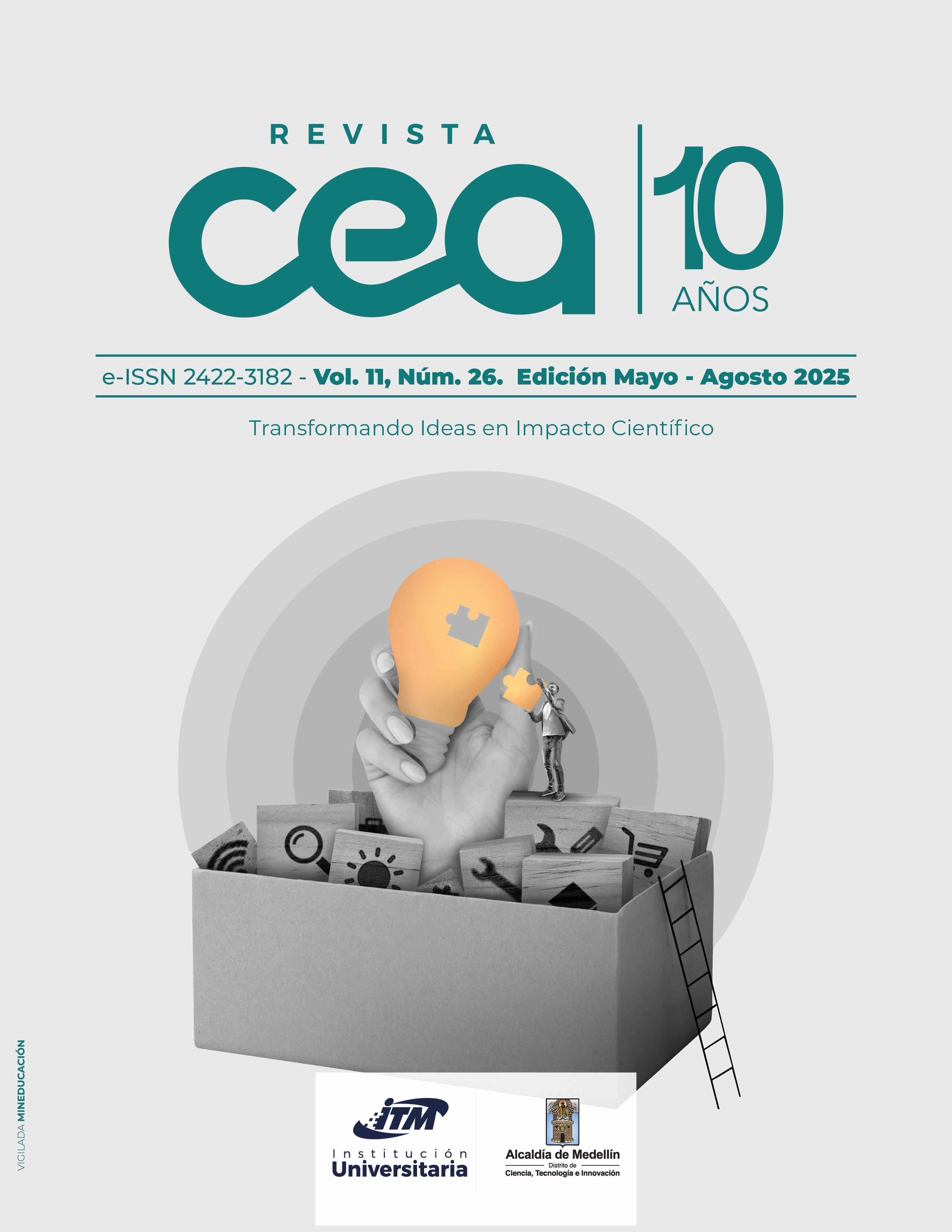Challenges and Opportunities of the Regional Innovation System in Norte de Santander (Colombia) for Boosting Business Competitiveness
Abstract
Objective: To explore how Regional Innovation Systems (RISs) interact and influence the development of dynamic capabilities in firms. In particular, the goal is to identify opportunities to improve collaboration and knowledge exchange among key actors within the RIS of Norte de Santander (Colombia).
Design/Methodology: A quantitative approach with a descriptive design was employed. To collect data, a questionnaire—validated by experts—was administered to 119 companies in the region. Subsequently, data analysis enabled the identification and characterization of the RIS’s main actors. As a result, a network map was created to visualize the connections between them.
Findings: Despite the presence of relevant actors in the RIS under study—such as service, commercial, and manufacturing firms; the National Training Service (abbreviated SENA in Spanish); the Universidad Francisco de Paula Santander; and various government entities—collaboration among them is still limited and poorly coordinated.
Conclusions: The lack of coordination hinders firms’ ability to develop dynamic capabilities necessary to adapt to changing environments and capitalize on innovation opportunities.
Originality: The study’s main contribution is a visual tool—network map—that illustrates the relationships between RIS actors and highlights areas for strengthening strategic alliances and enhancing business capabilities. Additionally, it offers an updated perspective on how the RIS under analysis operates in the region, with potential for application in similar contexts.
References
Alves, A. C., Barbieux, D., Reichert, F. M., Tello‐Gamarra, J., y Zawislak, P. A. (2017). Innovation and dynamic capabilities of the firm: defining an assessment model. Revista de Administração de Empresas, 57(3), 232-244. https://doi.org/10.1590/s0034-759020170304
Andreeva, T., y Ritala, P. (2016). What are the sources of capability dynamism? Reconceptualizing dynamic capabilities from the perspective of organizational change. Baltic Journal of Management, 11(3), 238-259. https://doi.org/10.1108/BJM-02-2015-0049
Asheim, B. T., Grillitsch, M., y Trippl, M. (2019). Regional innovation systems: Past, present and future. Revista Galega de Economía, 28(2), 4-22. https://doi.org/10.15304/rge.28.2.6190
Blomqvist, K., y Levy, J. (2006). Collaboration capability a focal concept in knowledge creation and collaborative innovation in networks. International Journal of Management Concepts and Philosophy, 2(1), 31. https://doi.org/10.1504/ijmcp.2006.009645
Breznik, L., y Hisrich, R. (2014). Dynamic capabilities vs. innovation capability: are they related? Journal of Small Business and Enterprise Development, 21(3), 368-384. https://doi.org/10.1108/jsbed-02-2014-0018
Caceres Caceres, H. A., y Sanches Vera, J. J. (2024). Metodología para comprender la interacción entre las organizaciones y el sistema regional de innovación en el desarrollo de capacidades dinámicas. Conocimiento Global, 9(2), 432-450. https://doi.org/10.70165/cglobal.v9i2.475
Calvo-Gallardo, E., Arranz, N., y Fernandez de Arroyabe, J. C. (2022). Contribution of the horizon2020 program to the research and innovation strategies for smart specialization in coal regions in transition: the spanish case. Sustainability, 14(4), 2065. https://doi.org/10.3390/su14042065
Cámara de Comercio de Cúcuta. (s.f.). Información General. https://www.cccucuta.org.co/
Cavusgil, S. T., y Deligonul, S. Z. (2025). Dynamic capabilities framework and its transformative contributions. Journal of International Business Studies, 56(1), 33-42. https://doi.org/10.1057/s41267-024-00758-8
Ceballos, M. (2004). Manual para el desarrollo del mapeo de actores claves–MAC. Consultoría técnica Gitec-Sercitec. https://www.gestiopolis.com/wp-content/uploads/2006/03/manual-5-manual-para-el-desarrollo-del-mapeo-de-actores-claves-mac-1.pdf
Chien, S., y Tsai, C. (2012). Dynamic capability, knowledge, learning, and firm performance. Journal of Organizational Change Management, 25(3), 434-444. https://doi.org/10.1108/09534811211228148
Cooke, P. (2001). Regional Innovation Systems, Clusters, and the Knowledge Economy. Industrial and Corporate Change, 10(4), 945-974. https://doi.org/10.1093/icc/10.4.945
Cooke, P., y Morgan, K. (1998). The regional innovation system: territory, institutions and innovation. Oxford University Press.
Danneels, E. (2010). Trying to become a different type of company: dynamic capability at Smith Corona. Strategic Management Journal, 32(1), 1-31. https://doi.org/10.1002/smj.863
Departamento Nacional de Planeación, y Observatorio Colombiano de Ciencia y Tecnología. (2021). IDIC Indíce Departamental de Innovación para Colombia 2020. DNP y OCyT. https://colaboracion.dnp.gov.co/CDT/Desarrollo%20Empresarial/IDIC-2020.pdf
Doloreux, D., y Parto, S. (2005). Regional innovation systems: Current discourse and unresolved issues. Technology in Society, 27(2), 133-153. https://doi.org/10.1016/j.techsoc.2005.01.002
Döme, V., Cycak, W., y Matus, K. J. (2025). Variations in innovation strategies for sustainable development: Sustainable innovation policy instrument mixes of ten small OECD countries across five sectors. Research Policy, 54(6), 105234. https://doi.org/10.1016/j.respol.2025.105234
Eisenhardt, K. M., y Martin, J. A. (2000). Dynamic Capabilities: What Are They? Strategic Management Journal, 21(10-11), 1105-1121. http://www.jstor.org/stable/3094429
Etzkowitz, H., y Leydesdorff, L. (2000). The dynamics of innovation: from National Systems and "Mode 2" to a Triple Helix of university-industry-government relations. Research Policy, 29(2), 109-123. https://doi.org/10.1016/S0048-7333(99)00055-4
García Pineda, V., Rojas Arias, J. P., Macías Urrego, J. A., y Rodríguez Correa, P. A. (2023). Identificación de capacidades de innovación en contextos universitarios virtuales: una aproximación desde una institución universitaria privada. Revista CEA, 9(21), e2678. https://doi.org/10.22430/24223182.2678
García Pineda, V., y Macías Urrego, J. A. (2021). Analysis of the Variables Leading to the Identification and Incorporation of Innovation Capabilities by Firms in the Colombian Ict Sector. Innovar, 32(84), 159-174. https://doi.org/10.15446/innovar.v32n84.99867
Grinis, V., y Valalyte, L. (2011). Regional innovation policy: from the development of innovation activities in the non-metropolitan regions of baltic sea region to the innovation policy memorandum. European Integration Studies, (5). https://doi.org/10.5755/j01.eis.0.5.1073
Guevara, W., Gómez-Camperos, J. A., y Jaramillo, H. Y. (2020). Competitividad e innovación en Norte de Santander. Aibi Revista de Investigación, Administración e Ingeniería, 8(S1), 295-306. https://doi.org/10.15649/2346030x.2473
Hardy, C., Phillips, N., y Lawrence, T. B. (2003). Resources, Knowledge and Influence: The Organizational Effects of Interorganizational Collaboration. The Journal of Management Studies, 40(2), 321-347. https://doi.org/10.1111/1467-6486.00342
Huggins, R., y Thompson, P. (2015). Entrepreneurship, innovation and regional growth: a network theory. Small Business Economics, 45(1), 103-128. https://doi.org/10.1007/s11187-015-9643-3
Jiao, H., Jiang, W., y Cui, Y. (2010). An empirical study on paths to develop dynamic capabilities: From the perspectives of entrepreneurial orientation and organizational learning. Frontiers of Business Research in China, 4(1), 47-72. https://doi.org/10.1007/s11782-010-0003-5
Jucevičius G., y Jucevičienė R. (2022). Enabling collaborative dynamic capabilities in strategic communities: Firm- vs. network-centric perspectives. Journal of Management & Organization, 28(3), 587-604. https://doi.org/10.1017/jmo.2022.37
Kang, B., y Oh, D. (2015). Institution for Regional Innovation System: The Korean Case. World Technopolis Review, 4(2), 46-61. https://doi.org/10.7165/wtr2015.4.2.46
Lawson, B., y Samson, D. (2001). Developing Innovation Capability in Organisations: A Dynamic Capabilities Approach. International Journal of Innovation Management, 5(3), 377-400. https://doi.org/10.1142/S1363919601000427
Leckel, A., Veilleux, S., y Dana, L. P. (2020). Local Open Innovation: A means for public policy to increase collaboration for innovation in SMEs. Technological Forecasting and Social Change, 153, 119891. https://doi.org/10.1016/j.techfore.2019.119891
Li, Y., Wei, Y., Li, Y., Lei, Z., y Ceriani, A. (2022). Connecting emerging industry and regional innovation system: Linkages, effect and paradigm in China. Technovation, 111, 102388. https://doi.org/10.1016/j.technovation.2021.102388
Lichtenthaler, U., y Lichtenthaler, E. (2009). A capability‐Based Framework for Open Innovation: Complementing Absorptive Capacity. Journal of Management Studies, 46(8), 1315-1338. https://doi.org/10.1111/j.1467-6486.2009.00854.x
Lundvall, B. Å. (ed.) (1992). National Systems of Innovation: Towards a Theory of Innovation and Interactive Learning. Pinter Publishers.
Madukwe, M. C., y Obiora, C. J. (2013). Identifying and Mapping Linkages between Actors in the Climate Change Innovation System. Journal of Agricultural Extension, 16(1). https://doi.org/10.4314/jae.v16i1.7
Mejía Osorio, A. M., y Duque Corrales, D. (2019). Dimensiones del proyecto de vida de los estudiantes de los grados 10° Y 11° del programa “Herencia del Saber” de la Institución educativa INEM “José Celestino Mutis” [tesis de grado, Corporación Universitaria Empresarial “Alexander Von Humboldt”]. Repositio Unab. http://hdl.handle.net/20.500.12749/6998
Mikalef, P., Boura, M., Lekakos, G., y Krogstie, J. (2019). Big Data Analytics Capabilities and Innovation: the Mediating Role of Dynamic Capabilities and Moderating Effect of the Environment. British Journal of Management, 30(2), 272-298. https://doi.org/10.1111/1467-8551.12343
Muñoz Ibarra, R. D., y Rózga Luter, R. E. (2022). Estrategias para el desarrollo de industrias de tecnología avanzada. El caso de la industria aeroespacial de Querétaro y Sonora. Región y sociedad, 34, e1549. https://doi.org/10.22198/rys2022/34/1549
Natário, M. M. S. (2014). Regional competitiveness: innovation, entrepreneurship and triple helix. International Journal of Economics & Management Sciences, 3(4), 1000204. https://doi.org/10.4172/2162-6359.1000204
Ortigueira-Sánchez, L. C., Stein, W. C., Risco-Martínez, S. L., y Ricalde, M. F. (2020). The Impact of Absorptive Capacity on Innovation in Peru. Journal of Technology Management & Innovation, 15(4), 19-29. https://doi.org/10.4067/s0718-27242020000400019
Ott, H., y Rondé, P. (2019). Inside the regional innovation system black box: Evidence from French data. Papers of the Regional Science Association, 98(5), 1993-2026. https://doi.org/10.1111/pirs.12446
Padilla-Ospina, A. M., Medina-Vásquez, J. E., y Ospina-Holguín, J. H. (2021). Financial Determinants of Innovation in Smes: A Machine Learning Approach. Journal of Small Business Strategy, 31(5). https://doi.org/10.53703/001c.29839
Pundziene, A., Nikou, S., y Bouwman, H. (2021). The nexus between dynamic capabilities and competitive firm performance: the mediating role of open innovation. European Journal of Innovation Management, 25(6), 152-177. https://doi.org/10.1108/ejim-09-2020-0356
Samara, E., Kilintzis, P., Katsoras, E., Martnidis, G., y Kosti, P. (2024). A system dynamics approach for the development of a Regional Innovation System. Journal of Innovation and Entrepreneurship, 13(26). https://doi.org/10.1186/s13731-024-00385-5
Schwartz, L., y Guaipatín, C. (2014). Ecuador: Análisis del Sistema Nacional de Innovación: Hacia la consolidación de una cultura innovadora. Banco Interamericano de Desarrollo. https://doi.org/10.18235/0012691
Teece, D. J., Pisano, G., y Shuen, A. (1997). Dynamic capabilities and strategic management. Strategic Management Journal, 18(7), 509-533. https://doi.org/d9mr5f
Tödtling, F., y Kaufmann, A. (1999). Innovation systems in regions of Europe—a comparative perspective. European Planning Studies, 7(6), 699-717. https://doi.org/10.1080/09654319908720549
Tseng, S., y Lee, P. (2014). The effect of knowledge management capability and dynamic capability on organizational performance. Journal of Enterprise Information Management, 27(2), 158-179. https://doi.org/10.1108/jeim-05-2012-0025
Uyarra, E. (2010). What is evolutionary about “regional systems of innovation”? Implications for regional policy. Journal of Evolutionary Economics, 20(1), 115-137. https://doi.org/10.1007/s00191-009-0135-y
Vega Zárate, C., Fernández Elías, R., Pozos Ceballos, S., y Ricárdez Jiménez, J. (2024). Análisis del índice global de innovación en américa latina y el caribe: miradas a su evolución. Interconectando Saberes, (17), 117-131. https://doi.org/10.25009/is.v0i17.2819
Villa-Enciso, E., García-Mosquera, J., Valencia-Arías, A., y Medina-Valderrama, C. J. (2023). Exploring the Role of Latin American Universities in the Implementation of Transformative Innovation Policy. Sustainability, 15(17), 12854. https://doi.org/10.3390/su151712854
Vu, H. M. (2020). A Review of Dynamic Capabilities, Innovation Capabilities, Entrepreneurial Capabilities and Their Consequences. Journal of Asian Finance Economics and Business, 7(8), 485-494. https://doi.org/10.13106/jafeb.2020.vol7.no8.485
Wang, C., y Ahmed, P. (2007). Dynamic capabilities: a review and research agenda. International Journal of Management Reviews, 9(1), 31-51. https://doi.org/10.1111/j.1468-2370.2007.00201.x
Wilke, U., y Pyka, A. (2025). Sustainable innovations, knowledge and the role of proximity: A systematic literature review. Journal of Economic Surveys, 39(1), 326-351. https://doi.org/10.1111/joes.12617
Wipo. (2020). Global Innovation Index 2020. https://www.wipo.int/en/web/global-innovation-index/2020/index
Yokura, Y. (2021). R&D Networks and Regional Innovation. En International perspectives in geography (pp. 27-43). Springer. https://doi.org/10.1007/978-981-16-2191-8_3
Zarębski, P., Czerwińska-Jaśkiewicz, M., y Klonowska-Matynia, M. (2022). Innovation in peripheral regions from a multidimensional perspective: Evidence from the Middle Pomerania region in Poland. Sustainability, 14(14), 8529. https://doi.org/10.3390/su14148529
Zhao, S., Cacciolatti, L., Lee, S., y Song, W. (2015). Regional collaborations and indigenous innovation capabilities in China: A multivariate method for the analysis of regional innovation systems. Technological Forecasting and Social Change, 94, 202-220. https://doi.org/10.1016/j.techfore.2014.09.014
Zou, B., Guo, F., y Song, M. (2017). Elastic and plastic innovation capability in firms. Industrial Management & Data Systems, 117(1), 198-212. https://doi.org/10.1108/imds-12-2015-0488
Downloads
Copyright (c) 2025 Harnol Alexander Caceres-Caceres, Juliana Andrea Salazar Parra, Moisés David Silva Reyes

This work is licensed under a Creative Commons Attribution-NonCommercial-ShareAlike 4.0 International License.

| Article metrics | |
|---|---|
| Abstract views | |
| Galley vies | |
| PDF Views | |
| HTML views | |
| Other views | |







